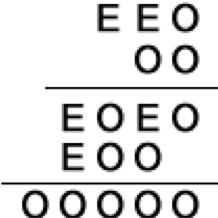Problems
Three friends – Peter, Ryan and Sarah – are university students, each studying a different subject from one of the following: mathematics, physics or chemistry. If Peter is the mathematician then Sarah isn’t the physicist. If Ryan isn’t the physicist then Peter is the mathematician. If Sarah isn’t the mathematician then Ryan is the chemist. Can you determine which subject each of the friends is studying?
We meet three people: Alex, Brian and Ben. One of them is an architect, the other is a baker and the third is an bus driver. One lives in Aberdeen, the other in Birmingham and the third in Brighton.
1) Ben is in Birmingham only for trips, and even then very rarely. However, all his relatives live in this city.
2) For two of these people the first letter of their name, the city they live in and their job is the same.
3) The wife of the architect is Ben’s younger sister.
Professions of family members. In the Smith family there are 5 people: a husband, a wife, their son, a husband’s sister and the father of his wife. They all work. One is an engineer, another is a lawyer, the third is a mechanic, the fourth is an economist, the fifth is a teacher. Here’s what else is known about them. The lawyer and the teacher are not blood relatives. The mechanic is a good athlete. He followed in the footsteps of an economist and played football for the national team of the plant. The engineer is older than his brother’s wife, but younger than the teacher. The economist is older than the mechanic. What are the professions of each member of the Smith family?
Burbot-Liman. Find the numbers that, when substituted for letters instead of the letters in the expression \(NALIM \times 4 = LIMAN\), fulfill the given equality (different letters correspond to different numbers, but identical letters correspond to identical numbers)
This problem is from Ancient Rome.
A rich senator died, leaving his wife pregnant. After the senator’s death it was found out that he left a property of 210 talents (an Ancient Roman currency) in his will as follows: “In the case of the birth of a son, give the boy two thirds of my property (i.e. 140 talents) and the other third (i.e. 70 talents) to the mother. In the case of the birth of a daughter, give the girl one third of my property (i.e. 70 talents) and the other two thirds (i.e. 140 talents) to the mother.”
The senator’s widow gave birth to twins: one boy and one girl. This possibility was not foreseen by the late senator. How can the property be divided between three inheritors so that it is as close as possible to the instructions of the will?
In the language of the Ancient Tribe, the alphabet consists of only two letters: M and O. Two words are synonyms, if one can be obtained by from the other by a) the deletion of the letters MO or OOMM, b) adding in any place the letter combination of OM. Are the words OMM and MOO synonyms in the language of the Ancient Tribe?
An investigation is being conducted into the case of a stolen mustang. There are three suspects – Bill, Joe and Sam. At the trial, Sam said that the mustang was stolen by Joe. Bill and Joe also testified, but what they said, no one remembered, and all the records were lost. In the course of the trial it became clear that only one of the defendants had stolen the Mustang, and that only he had given a truthful testimony. So who stole the mustang?
True or false? Prince Charming went to find Cinderella. He reached the crossroads and started to daydream. Suddenly he sees the Big Bad Wolf. And everyone knows that this Big Bad Wolf on one day answers every question truthfully, and a day later he lies, he proceeds in such a manner on alternate days. Prince Charming can ask the Big Bad Wolf exactly one question, after which it is necessary for him to choose which of the two roads to go on. What question can Prince Charming ask the Big Bad Wolf to find out for sure which of the roads leads to the Magic kingdom?
Decipher the following puzzle. All the numbers indicated by the letter E, are even (not necessarily equal); all the numbers indicated by the letter O are odd (also not necessarily equal).

In a vase, there is a bouquet of 7 white and blue lilac branches. It is known that 1) at least one branch is white, 2) out of any two branches, at least one is blue. How many white branches and how many blue are there in the bouquet?